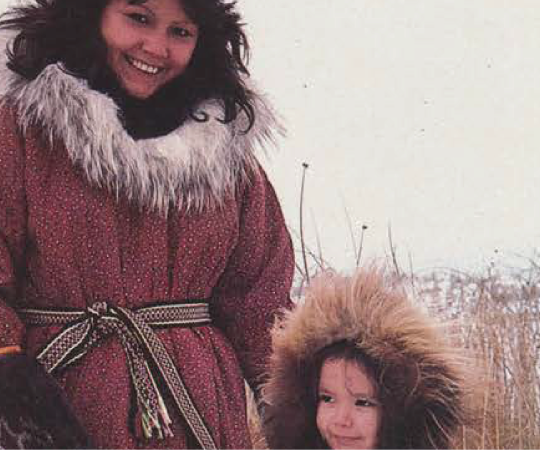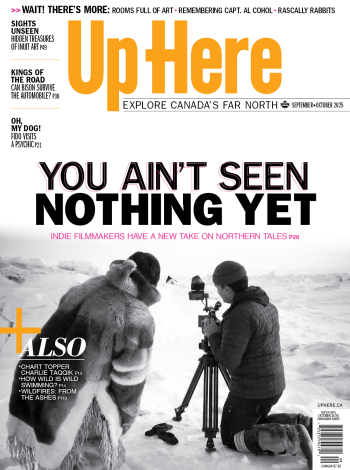Steam swirls off tuktu stew and around Anna Lambe as she pulls a tray of golden-brown biscuits from the oven in Iqaluit’s Inuksuk High School. It’s 11:55 a.m. on a Wednesday. Lunch is served at noon—and there’s a queue snaking out of the cafeteria.
This is just another regular Wednesday for Lambe. The Grade 12 student is part of a five-student team which, along with food studies teacher Lael Kronick, has spent the last year planning and cooking free school lunches three times a week. On Monday it was quesadillas with fresh salsa. Today it’s boiled caribou with salad and biscuits.
“This program essentially is giving students who may be disadvantaged by being food insecure the opportunity to have lunch in school to help with their education,” says Lambe, who will start a degree in International Development and

Every few weeks, Kronick, Lambe, and four of her peers meet and sketch out a meal plan for the upcoming month. The program is mostly student-run, says Kronick. That gives them an opportunity to take ownership of the program’s form and the food on offer while teaching them how to cook and giving them some work experience in the kitchen.
Meals are dictated by the availability of country food, teacher and student suggestions, and the team’s culinary curiosity. They’ve tried Mexican, Syrian, and Jamaican dishes, sometimes substituting certain ingredients for country food.
They try to incorporate seal or caribou as often as possible because not everyone has the necessary equipment to get out and hunt. “A lot of students cannot afford to have country food and it’s essential that it’s provided to students,” says Lambe.
They purchase food from local stores or Kivalliq Arctic Foods in Rankin Inlet. Sometimes, they will source country food from local harvesters, adapting the menu around what’s available.
Then the work starts. Chopping vegetables. Thawing char. Making bannock. Harvesting greens from the school’s hydroponic garden. For a few hours in the middle of the day, the kitchen is thrumming with energy. The core team is joined by a steady flow of friends, teachers, and community members pitching in to help.
That’s Lambe’s favourite part. “Working in this kitchen with other students, especially preparing large meals for others, it requires teamwork,” she says. “We must work together and be able to communicate. It builds a community of people, and there’s a lot of problem-solving about how we’re going to get this done.”
“A lot of students cannot afford to have country food, and it’s essential that it’s provided to students.” Anna Lambe
Inevitably, problems arise. A flight is delayed, so ingredients are missing and substitutes must be found. A drain gets blocked and needs cleaning. Someone misjudges how much watermelon students will eat. And three days every week, there’s a long line of people eagerly waiting for their hot lunch.But Lambe doesn’t mind the chaos of cooking for large groups. She inherited her father’s passion for food and thrives off cooking. “I love to strengthen my relationship with food—and healthy food—through cooking, and give myself a release of creativity and stress through food,” she says. It’s an experience she hopes other students in the territory will have one day. She’s developed guidelines to help them create free lunch programs tailored to their needs at their own schools. But it may take more than that. Lambe points to a lack of consistent funding for lunch programs in the territory. Providing lunches at Inuksuk High School costs about $50,000 for the year, a cost that’s been covered by two-year grants. They also received money to buy and operate the small hydroponic garden in the middle of the cafeteria, where they grow leafy greens and herbs for their salads. And the school already had an industrial kitchen and plenty of enthusiastic volunteers.
It’s worked for them this year, but it all could end if the grants are not renewed or if Kronick can’t continue to devote her time to coordinate the program. “There’s no way around it, you need a head of program. Any school that would want to implement a program like this would have to have somebody that devotes a lot of their time to it,” says Lambe. And ideally, future programs would have enough money to hire students, giving them part-time jobs and helping them to hone their cooking skills.
Lambe sees her guidelines as a starting point for other schools to develop their own programs. But that comes later. Right now, it’s 12:05 p.m. and the hungry students of Inuksuk High School are waiting for biscuits and caribou.










